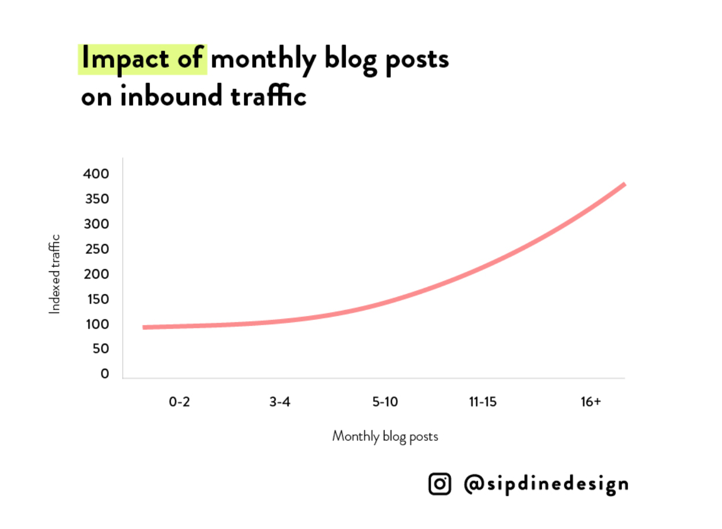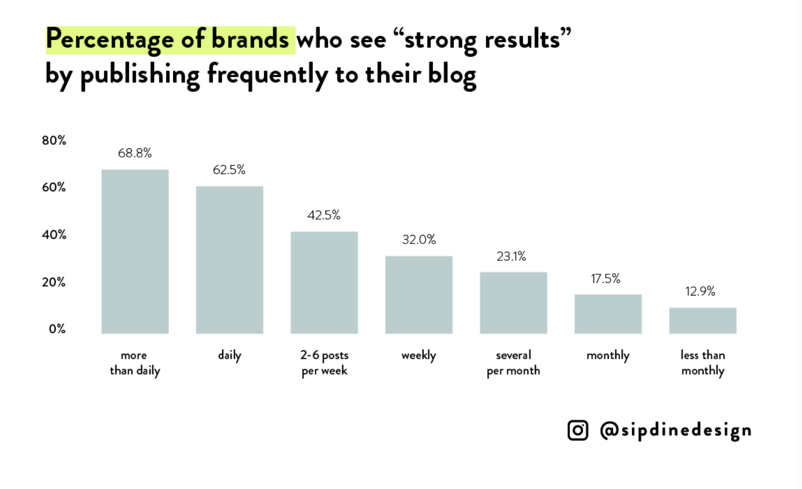Forbes posts over 1500 articles to their blog every month. Huffington Post publishes a blog post every 58 seconds, which adds up to over 1500 articles Every. Single. Day. . 53% of marketers say blogging is their top content marketing priority, and that definitely is the case for the aforementioned websites. But should it be the top priority for your business as well? And what if you don’t have the time or the budget to post that frequently? Don’t fear- you don’t have to chain yourself to your computer cranking out blog posts like a machine in order for your business to be successful. While I think it’s safe to say that posting content to your blog is a solid marketing strategy, and you do need a content strategy mapped out in order to drive traffic to your website and help your business grow, but a solid content strategy doesn’t necessarily mean posting hundreds of articles every month. So how much should you post? The answer to that is dependent on your specific business, your goals and expectations, and your time and budget constraints.

image 1
The most important thing to consider isn’t how much you’re posting, but what you’re posting.
The age-old adage applies to SEO and blog posting as well: quality over quantity. There is SO MUCH content posted every day that if you focus on churning out hundreds of mediocre posts they’ll just get lost in the millions of other mediocre posts published online every single day. You want your content to stand out, and not just because you’re publishing so much of it; it should stand out because it’s good. One great blog post will drive more traffic to your site than 100 sub-par ones, guaranteed. That being said, if you have the time (or the team) to publish 10 quality posts a month, that’s not a bad strategy either…but never sacrifice quality for quantity.
Think about your business goals, and keep it real.
Neil Patel wanted to get 100,000 visitors to his website as quickly as possible, so he decided to start publishing 2 blog posts a week instead of 1. This strategy was so successful that he continued to post twice a week until he reached his goal in less than a year. Part of why he was so successful was that he set a tangible goal and created a realistic strategy to obtain it. For most small business owners, going from one to two blog posts a week should be pretty doable. Be wary of creating lofty goals for yourself; it’s great to dream big, but chances are if you’re only writing one post a week now it’s just not realistic to say that you’re going to start writing 20 every month (which is ok, because you don’t need to mass produce content to see results).

image 2
Consider your niche.
Your goals should be dependent on your specific market as well. If you’re writing a news blog, posting once or twice a week isn’t going to cut it. You’re competing with websites that are posting multiple times a day in order to stay on top of everything that’s happening in society. Look at your competitors, see how often they’re posting, and try to come as close as you can to publishing the same number. For news blogs, this probably means posting at least once a day, if not more. Tech blogs, food blogs, fashion blogs, etc. can get away with less. This article tells you how to generate a year’s worth of blog post ideas so you’re never scrambling for content at the last minute.
It’s not just about the writing…
Remember that a solid content strategy doesn’t stop with creation; in fact, that’s only the beginning. Once you’ve written a quality post, you need to promote it as much as you can. Share it on your social media platforms, reach out to other websites to try to get backlinks, send it out through your email list, etc. While some people will find your post organically, you’ll have a lot more success if you put as much effort into sharing the post as you did writing it.

The Huffington Post Mission Statement (Image 3)
All that being said, the magic number is usually somewhere between 1-3 posts a week.
Now that there is so much content available online, it’s easy for readers to get overwhelmed and burnt out. Most people don’t want to be inundated with content from the website every single day. And, if you’re only posting once or twice a week, it shouldn’t be a problem to make sure your articles are well thought-out, well-written, and relevant to your audience. Remember, quality over quantity. Also, if you’re only posting a few times a week, your odds are better that your audience will engage with your posts by commenting, liking, and sharing them.
Consider writing your posts in advance and then scheduling them to be published on specific days and times based on when your audience is most active. Many businesses have also found success by creating a content calendar every month. It’s a great way to stay organized and ensure that you’re not wearing out a topic by blogging on it too much. Also, if your readers get used to you posting new content every Monday, Wednesday, and Friday, for example, they’ll know to check your website on those days and you’ll see a spike in traffic.
In addition to checking out your competition to see how often they’re posting, also look at what they’re posting, and their readers’ responses to it. What kinds of posts do well, and which ones are a flop? Don’t copy their exact ideas, but there’s no reason to start brand new. Follow their example by adapting successful topics to your business and presenting them in a new and fresh way.

Forbes live streams how many people are reading their articles at any given time. (Image 4)
The Takeaway…
While we suggest 1-3 posts per week, only you can decide what the right number is for your business. Think about your goals, plan your content in advance, check out your competition, and then start writing. If you don’t see the jump in traffic that you’d like, revise your strategy and try again. Writing should never seem like a chore; if you’re bored and uninspired by your articles, your audience probably is too. Only take on as much as you can handle to ensure your posts are of a high quality.
Think about this; if you only had time to read one blog post today, would it be the one you’re writing? If the answer is no, something needs to change. 43% of people skim blog posts; make yours one they stop to actually read.
How often are you posting content to your website? Check out this article by marketing cartel for more on this topic!
Image 1: sipdinedesign.com
Image 2: sipdinedesign.com
Image 3: huffingtonpost.com
Image 4: Forbes.com







